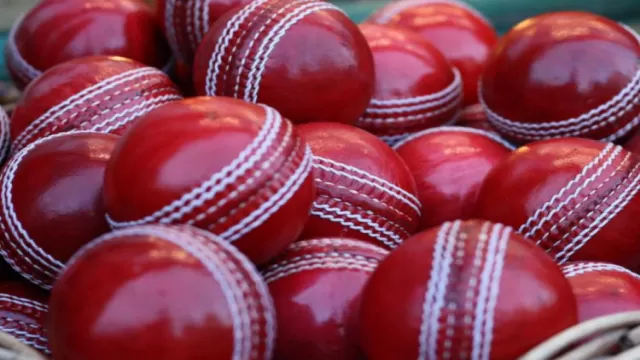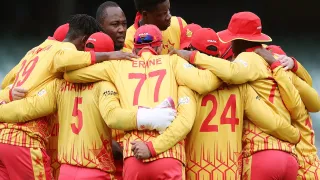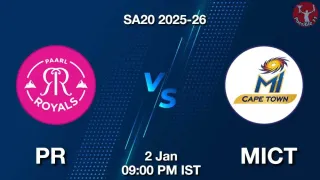Image Source: Twitter
Cricket, often hailed as the gentleman's game, is known for its diverse formats and unique equipment. One crucial piece of equipment that greatly impacts the dynamics of the game is the cricket ball. Cricket balls come in various types, exhibiting different behaviors based on their manufacturing, specifications, and colors associated with different formats. In this comprehensive blog post, we will delve into the details of cricket balls used in one-day and test cricket, exploring international specifications, manufacturing materials, and the reasons behind the usage of different-colored balls.
Cricket Ball Manufacturers
In the realm of professional cricket, a limited number of approved manufacturers provide balls for the game. Among these, the prominent brand Kookaburra, originally used solely by the Australian Cricket Board, is now widely employed in One-Day Internationals (ODIs), Twenty20 (T20) matches, and test matches across Australia and other cricket-playing nations. However, two exceptions exist to this general rule. In England, the Dukes cricket ball dominates all professional levels of the game, while in India, the SG ball is more commonly utilized.
Distinguishing Characteristics of Cricket Balls
While conforming to the overall laws governing size and weight, cricket balls from different manufacturers possess certain unique characteristics. The Kookaburra ball, for instance, tends to deteriorate after approximately 20 to 30 overs, affecting its swing and spin attributes. Conversely, the Dukes ball boasts a longer-lasting seam, making it the preferred choice for seam and swing bowlers. The SG ball, almost exclusively used in India, quickly loses its shine, rendering it favorable for spinners but offering little advantage to seamers.
Types of Cricket Balls in Professional Cricket
For any game of cricket, the ball stands as an essential piece of equipment, carrying an intricate design and a non-spherical shape due to the presence of a seam along its circumference. Let's explore the various types of cricket balls used in professional cricket.
Red Leather Balls

Image Source: Twitter
The red cricket ball, which originated as the traditional ball for decades, remains in use exclusively for daytime first-class and test cricket matches. Manufactured using a cork center, tightly bound string, and a dyed red leather casing, red balls are known for their durability and high visibility, facilitating their spotting by umpires and players.
White Leather Balls

Image Source: Twitter
White cricket balls have become the norm for all limited-overs matches worldwide, including 50-over One-Day Internationals and Twenty20 contests. Originally introduced for day-night matches played under floodlights, white balls replaced the red balls due to their enhanced visibility. While manufactured in the same manner as red balls, white balls exhibit certain differences. They tend to swing more in the early stages of a match but lose their swinging characteristics quickly. Additionally, white balls can become discolored and challenging to spot after around 30-40 overs. To counter this, the fielding side now uses two new balls at the start of the 50-over innings in ODI cricket.
Pink Balls

Image Source: Twitter
The latest addition to the official cricket ball family is the pink ball, primarily used in day-night test matches and first-class games played under floodlights. Day-night test cricket, experimented with since 2009, gained significant popularity, leading to the introduction of a distinct ball color to ensure visibility. Since players wear traditional white clothing during these matches, white balls were not suitable, and red balls were hard to see in night-time conditions. Thus, a bright pink ball emerged as a viable compromise. The pink ball, durable and highly visible, allows players and umpires to track it effortlessly throughout the game.
Conclusion
Cricket balls play a crucial role in determining the outcome of matches in different formats of the game. Manufacturers such as Kookaburra, Dukes, and SG produce balls that exhibit distinct characteristics. Red leather balls find their place in traditional test cricket, while white leather balls have become synonymous with limited-overs matches. The introduction of pink balls has revolutionized day-night test cricket, ensuring enhanced visibility without clashing with players' attire. Understanding the variations and qualities of different cricket balls adds depth and intrigue to the game, captivating players and fans alike.
Disclaimer
Possible11 is a sports news and analysis platform designed purely for entertainment and educational purposes. All match previews, player insights, and team analyses are based on publicly available information and expert opinions. We do not promote or support betting, gambling, or real-money gaming in any form. Users are encouraged to enjoy our content responsibly and use it for informational purposes only.
































Give Your Feedback